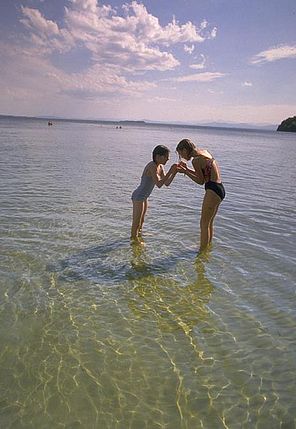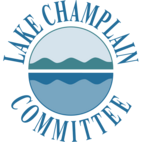Monitoring Cyanobacteria Blooms
July 2014

Summertime brings throngs of residents and visitors to the shores of Lake Champlain. But summertime can also means the return of blue-green algae blooms. Fortunately, there is a program in place to let those recreating on the lake and researchers know when and where blooms are occurring on a week to week basis.
Blue-green algae (also known as cyanobacteria) are a natural part of our ecosystem. They were among the first organisms to evolve on the planet. There are numerous different species of them inhabiting every ecosystem on earth: freshwater, saltwater, forests, deserts, even glaciers.
Sometimes, under some conditions, blue-green algae form unsightly blooms in lakes. Blooms are most likely in waters with high nutrient concentrations. They usually occur when the weather is very hot and the air still. Turbulent air causes waves that can disrupt the formation of blooms. With our summers getting warmer blooms may be becoming more frequent.
There are concerns about blue-green algae blooms apart from just aesthetic disgust. Swimming in a bloom can cause skin rashes and stomach illnesses. Aerosolized water droplets with algae in them can produce allergy-like symptoms. Some species under some conditions can produce toxins that affect the liver, while other species' compounds affect the nervous system. Dog deaths have been associated with ingesting too much of the green scum.
To track the frequency and severity of blue-green algae outbreaks on Lake Champlain, the Lake Champlain Committee (LCC) has coordinated a volunteer monitoring effort since 2003. “The blue green algae monitoring partnership is a remarkable collaboration of citizen scientists and state agencies with the key role being played by the Lake Champlain Committee, which facilitates training, education, and data collection activities" notes David Grass, Environmental Health Surveillance Chief for the Vermont Department of Health. "This collective effort to monitor the health of the lake in a standardized, scientifically rigorous fashion is unique in the county and provides a valuable service to lake-goers.”
For the first eight years of the program, volunteers collected water samples, which were analyzed at the University of Vermont for the presence of blue-green algae and their toxins. Collecting and processing samples took up to four days, and by the time results were available, conditions could have changed dramatically. Meanwhile, the time and cost of lab analysis significantly limited the number of sites that were monitored.
In 2011 LCC switched to a primarily visual monitoring system. While water samples are still analyzed from select locations around the lake, most monitors now make visual observations and report back to LCC using an on-line form. The approach offers less quantitative results, but greatly increases the scope of the program which has grown from 14 monitoring sites to over 60. LCC trains all monitors how to recognize blue-green algae and assess and report on water quality. The training also includes actions to take to reduce their frequency. Monitors report once a week from the same location and submit additional reports in the event of a bloom. LCC works with the Vermont and New York Departments of Health and Environmental Conservation to ensure the program's technical rigor and share results. The Vermont Department of Health hosts an on-line map where all reports are compiled and can be accessed by the public. Anyone with an internet connection can click on a dot on the map and find out the lake conditions during the time of the most recent report.
One advantage of the program is that through LCC's training and outreach there are now numerous people throughout the Lake Champlain Basin who recognize blue-green algae, are aware of the potential risks, and are more informed about actions to take to reduce blooms. In the last few weeks alone LCC trained nearly 300 people to assess water conditions. Not all go on to monitor, but the increase in general awareness of the topic is tremendous.
Algae conditions can vary widely over short time frames and close distances making them difficult to study. While a bloom might occur on one isolated bay, the next cove over can be algae free. While some blooms persist for days, others pop up and then disappear within a span of hours.
The monitoring program gives a more reliable estimate of how frequently blooms occur on the lake. LCC’s monitors provide a randomized, but widespread assessment of conditions on a week to week basis. In 2013 LCC received 557 regular weekly reports from the monitors between mid-June and early September, and 97% of the reports indicated no blue-green algae present. Not surprisingly, algae were more common from St. Albans Bay (8% of reports) and Missisquoi Bay (7%). Results from 2012 were similar.
The relative infrequency of reports of algae blooms may come as a surprise. When blooms do occur they attract widespread attention. The media reports on the event increasing the audience that hears about it. As a result, blooms stick in people’s memories. Meanwhile, the absence of blooms is routine, normal, everyday. Days without blooms don’t draw media attention, or memorable photographs.
Events like algae blooms that are easy to recall are often considered more common or more important than they actually are. This phenomenon has been called the “availability heuristic” by psychologist Daniel Kahneman, who won a Noble Prize in economics despite never studying economics. Another example of the availability heuristic can be seen with household chores. When each member of a married couple assesses the percentage of chores they do, inevitably the total exceeds 100%. Each person remembers the chores they do, they come more easily to mind, like algae blooms come more easily to mind than do days when the water is clear.
Systematically collecting data on the frequency of algae blooms helps avoid biases created by the availability heuristic. With perhaps five years of data LCC’s monitors will provide better rounded picture of the lake’s condition than we have today. In the meantime, the weekly reports offer beach managers and those looking for a place to swim an up-to-date assessment of conditions on the lake.
The blue green algae monitoring program is made possible with the support of LCC members, the Lake Champlain Basin Program, PC Construction, the Lintilhac Foundation, South Lake Champlain Fund, and the Hickok and Boardman Network of Companies. Contact the Lake Champlain Committee at lcc@lakechamplaincommittee.org or 802 658-1414 to get involved.
Lake Look is a monthly natural history column produced by the Lake Champlain Committee (LCC). Formed in 1963, LCC is the only bi-state organization solely dedicated to protecting Lake Champlain’s health and accessibility. LCC uses science-based advocacy, education, and collaborative action to protect and restore water quality, safeguard natural habitats, foster stewardship, and ensure recreational access.
Get involved by joining LCC using our website secure form (at www.lakechamplaincommittee.org), or mail your contribution (Lake Champlain Committee, 208 Flynn Avenue - BLDG 3 - STUDIO 3-F, Burlington, VT 05401), or contact us at (802) 658-1414, or lcc@lakechamplaincommittee.org for more information.
